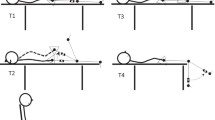Abstract
Background
The patellar tendon reflex (PTR) is an important spinal reflex and an important diagnostic tool assessing neurological disturbances. Reflexes are conveniently assessed but quantifying the response can be subjective. Motion analysis is commonly used to assess gait kinematics in a variety of populations. It can be used to objectively assess the PTR with the advantage that standard technique and hammer can be used without the need for bulky apparatus or fixing the subject position.
Aim
To compare the PTR in 15 cerebral palsy (CP) children with age and height matched controls.
Methods
EMG reflex latency in the rectus femoris was assessed using a Noraxon 2400T unit. Knee movement latency, knee angular displacement and peak angular velocity were captured using the CODA mpx 30 system.
Results
EMG reflex latency was significantly reduced in CP compared to control limbs (13.11 versus 18.11 ms; p < 0.01) confirming a ‘brisk’ response in this population. The kinematic data found that while knee angular displacement was significantly reduced in CP (12.82° versus 20.06°; p < 0.01) there was no significant difference in movement latency or peak angular velocity compared to controls.
Conclusions
Subjective evaluation of the PTR relies mostly on change in knee angle. Using motion analysis we have confirmed a difference in this variable in CP compared to controls. We have also shown reduced reflex latency associated with a brisk reflex. Knee movement latency and peak angular velocity did not differentiate CP from normal. Further examination of the knee angular response of the PTR is warranted in CP.


Similar content being viewed by others
References
Dafkin C, Green A, Kerr S, Veliotes D, McKinon W (2013) The accuracy of subjective clinical assessments of the patellar reflex. Muscle Nerve 47(1):81–88 (PubMed PMID: 23169260. Epub 2012/11/22. eng.)
Walker HK (1990) Deep tendon reflexes. In: Walker HK, Hall WD, Hurst JW (eds) Clinical methods: the history, physical and laboratory examinations. Butterworth Publisher, Boston, pp 365–368
Marshall GL, Little JW (2002) Deep tendon reflexes: a study of quantitative methods. J Spinal Cord Med Summer 25(2):94–99 (PubMed PMID: 12137223. Epub 2002/07/26. eng.)
Lebiedowska MK, Sikdar S, Eranki A, Garmirian L (2011) Knee joint angular velocities and accelerations during the patellar tendon jerk. J Neurosci Methods 198(2):255–259 (PubMed PMID: 21549755. Epub 2011/05/10. eng.)
Jang DH, Sung IY, Kang YJ (2013) Usefulness of the tendon reflex for assessing spasticity after botulinum toxin-a injection in children with cerebral palsy. J Child Neurol 28(1):21–26 (PubMed PMID: 22832767. Epub 2012/07/27. eng.)
Mamizuka N, Sakane M, Kaneoka K, Hori N, Ochiai N (2007) Kinematic quantitation of the patellar tendon reflex using a tri-axial accelerometer. J Biomech 40(9):2107–2111 (PubMed PMID: 17140585. Epub 2006/12/05. eng.)
Simons DG, Lamonte RJ (1971) Automated system for the measurement of reflex responses to patellar tendon tap in man. American journal of physical medicine 50(2):72–79 (PubMed PMID: 5580262. Epub 1971/04/01. eng.)
Van de Crommert HW, Faist M, Berger W, Duysens J (1996) Biceps femoris tendon jerk reflexes are enhanced at the end of the swing phase in humans. Brain Res 734(1–2):341–344 (PubMed PMID: 8896845. Epub 1996/09/23. eng.)
Pereon Y, Nguyen The Tich S, Fournier E, Genet R, Guiheneuc P (2004) Electrophysiological recording of deep tendon reflexes: normative data in children and in adults. Neurophysiol Clin Clin Neurophysiol 34(3–4):131–139 (PubMed PMID: 15501682. Epub 2004/10/27. eng.)
Tham LK, Abu Osman NA, Wan Abas WA, Lim KS (2013) The validity and reliability of motion analysis in patellar tendon reflex assessment. PLoS ONE 8(2):e55702 (PubMed PMID: 23409022. Pubmed Central PMCID: PMC3567131. Epub 2013/02/15. eng.)
Frijns CJ, Laman DM, van Duijn MA, van Duijn H (1997) Normal values of patellar and ankle tendon reflex latencies. Clin Neurol Neurosurg 99(1):31–36 (PubMed PMID: 9107465. Epub 1997/02/01. eng.)
Stam J, van Crevel H (1989) Measurement of tendon reflexes by surface electromyography in normal subjects. J Neurol 236(4):231–237 (PubMed PMID: 2760635. Epub 1989/05/01. eng.)
Stam J, van Crevel H (1990) Reliability of the clinical and electromyographic examination of tendon reflexes. J Neurol 237(7):427–431 (PubMed PMID: 2273412. Epub 1990/11/01. eng.)
Lebiedowska MK, Fisk JR (2003) Quantitative evaluation of reflex and voluntary activity in children with spasticity. Archiv Phys Med Rehabil 84(6):828–837 (PubMed PMID: 12808534. Epub 2003/06/17. eng.)
Tham LK, Osman NA, Lim KS, Pingguan-Murphy B, Abas WA, Zain NM (2011) Investigation to predict patellar tendon reflex using motion analysis technique. Med Eng Phys 33(4):407–410 (PubMed PMID: 21146440. Epub 2010/12/15. eng.)
Palisano R, Rosenbaum P, Walter S, Russell D, Wood E, Galuppi B (1997) Development and reliability of a system to classify gross motor function in children with cerebral palsy. Dev Med Child Neurol 39(4):214–223 (PubMed PMID: 9183258. Epub 1997/04/01. eng.)
SENIAM. Surface ElectroMyoGraphy for the Non-Invasive Assessment of Muscles: Biomedical Health and Research Program (BIOMED II) of the European Union. http://www.seniam.org/
Schillings AM, Van Wezel BM, Mulder T, Duysens J (1999) Widespread short-latency stretch reflexes and their modulation during stumbling over obstacles. Brain Res 816(2):480–486 (PubMed PMID: 9878872. Epub 1999/01/08. eng.)
Kuruoglu R, Oh SJ (1993) Quantitation of tendon reflexes in normal volunteers. Electromyogr Clin Neurophysiol 33(6):347–351 (PubMed PMID: 8223334. Epub 1993/09/01. eng.)
Wartenberg R (1951) Pendulousness of the legs as a diagnostic test. Neurology 1(1):18–24 (PubMed PMID: 14785753. Epub 1951/01/01. eng.)
Szopa A, Domagalska-Szopa M, Kidon Z, Syczewska M (2014) Quadriceps femoris spasticity in children with cerebral palsy: measurement with the pendulum test and relationship with gait abnormalities. Journal of neuroengineering and rehabilitation 11:166 (PubMed PMID: 25516151. Pubmed Central PMCID: PMC4277843. Epub 2014/12/18. eng.)
Author information
Authors and Affiliations
Corresponding author
Ethics declarations
Conflict of interest
No conflict of interest has been declared by any of the authors.
Ethical standard
Ethical approval was obtained from the local ethics committee and informed consent was obtained from all participants.
Rights and permissions
About this article
Cite this article
O’Sullivan, R., Kiernan, D., Walsh, M. et al. Characterisation of the patellar tendon reflex in cerebral palsy children using motion analysis. Ir J Med Sci 185, 813–817 (2016). https://doi.org/10.1007/s11845-015-1369-3
Received:
Accepted:
Published:
Issue Date:
DOI: https://doi.org/10.1007/s11845-015-1369-3




